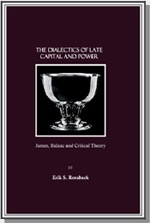
Editor-in-chief: Georges-Claude Guilbert
Book Review Editor: Molly O'Brien Castro
![]()
Erik S. Roraback, The Dialectics of Late Capital and Power: James, Balzac and Critical Theory (Newcastle: Cambridge Scholars Publishing, 2007). £34.99, 320 pages, ISBN: 1-84718-226-7 - Gerardo Del Guercio, York College, CUNY.
Erik S. Roraback’s book, The
Dialectics of Late Capital and Power: James, Balzac and Critical Theory,
explores the areas of cruelty, abuse, and the inter-relationships
that form when capital is used as a method of gaining power in the
works of American author Henry James and the French writer Honoré
de Balzac. The texts Roraback criticizes are Balzac’s Eugénie
Grandet, James’s Washington Square, ‘The Aspern Papers’,
The Princess Casamassima, The American Scene, The Wings of Dove,
The Ambassadors, and The Golden Bowl. Together, these
two Occidental novelists composed a fresh inter-disciplinary viewpoint
that encompassed what later became termed psychoanalysis, as well
as Marxism, Leninism, and other modernist theories to propose a changing
world-view. The weltanschauung Roraback proposes is that
capital and power must be eliminated to realize non-violence. In sum,
Roraback repositions important English, French, America, and German
philosophies of the late nineteenth century and twentieth-century
so that they remain relevant and fresh to a twenty-first century reader.
Professor Erik S. Roraback teaches critical theory, international
cinema, James Joyce, and American Literature, at Charles University
at Prague.
This tome’s ‘Introduction’ begins with a detailed
discussion of Benedict de Spinoza and how his theories structure ‘our
basic contention for the true and authentic use and form of the oft-wonderful
thing of money capital: the new and more conceptually and theoretically
deep rich notion of ‘unmoney’’ [1]. Roraback later
correlates ‘un-money’ with another broadly theoretical
term he calls ‘un-power’ [7], or an ‘informed heterodox
and marginal secular theory for contemporary thought, that power as
domination, hegemony, and intimidation is not an eternal foundation
stone’ [7]. According to Roraback’s, the concept of money
and power are therefore not limited to one type of person, but that
they are fundamentally alterable and transferable to others.
The relationship between money and cruelty is another key one in this
tome’s introduction. Roraback brings in several theories Frederic
Jameson presents in The Seeds of Time to pair the ‘scared
and power’ [6]. In doing so, Roraback’s book deviates
from other studies given that it ‘constitutes a taxonomic attempt
to classify different micro-level [...] and macro-level [...] fraudulently
sacral powers, capitals, cruelties and violences by examining their
individual and particular connections to secular and resisting forms
of counter-cruelty / extra-money / non-power / non-violence in James
- Balzac’ [6]. In dealing with these injustices, Roraback ultimately
advocates that dealing with the description, identification, naming,
and classification of organisms is oppressive and counter-productive
to human development. I argue that Roraback proposes that this power
be shifted from a predominantly male ownership to a subaltern one
— most notably women. By shifting this power the world might
return to a maternal phase that goes against war, poverty, crime,
and other forms of injustice, especially violence.
The tome’s second arc is composed of chapters one to three.
These essays assert that a form of ‘non-power/counter cruelty
social form of resistance against stifling spirits of negatively snobbish
normality of Balzac’s literary example in his life-narrative
and his life work’ [158]. This dialectic is applied to James’s
fiction in the way James makes concrete abstract terms like counter-cruelty
/ extra-money / extra-capital / and non-power. I argue that Roraback’s
use of the forward slash to separate these terms demonstrates the
progressions that are possible in these theories so that they remain
pertinent to a twenty-first century audience.
Chapters four and five introduce Henry James’s 1886 novel The
Princess Casamassima in relation to French theorists like Louis
Althusser or Jacques Rancière. The contention in chapters four
and five is to explore the power held by the upper-middle class and
the ideologies that formed in this class to control cultural capital
and create theories that correlate ideology and subject position.
James and Balzac adopted this dogma from their Victorian predecessors,
including John Ruskin and Walter Pater.
Roraback shifts to an investigation on wealth, medicine, composition,
and hermeneutics in chapters six and seven. Applying a close reading
of The Wings of the Dove and The Ambassadors, Roraback
explains how James’s use of meandering sentences and paragraphs
were justified because of James’s critique of medicine and its
relation to practical/cultural practices. In his penultimate section,
Roraback introduces the theories of Jacques Derrida, Michael Foucault,
as well as Jacques Lacan’s conception of ‘transference’
[201] to build on more contemporary readings of James and Balzac.
This tome ends with an exploration of James late novel The Golden
Bowl. A book that is in general terms on education, The Golden
Bowl explores how protagonist Maggie slowly discards her naïveté
and grows into a competent female who saves her marriage by deft handling
of a potentially volatile state of affairs. Maggie ultimately understands
that she is unable to stay dependent on her father, but must accept
grown-up responsibilities in her marriage. Roraback uses the philosophies
of Martin Heidegger to demonstrate how Maggie steps out of her childlike
state and enters one of independence. Maggie therefore becomes her
own ‘Being’ because she no longer requires her father’s
authority and capital to survive in society. Consequently, Maggie
develops into a ’new woman’ who is capable of resolving
her own problems.
The Dialectics of Late Capital and Power: James, Balzac and Critical
Theory successfully presents new ways of discussing late-nineteenth
and twentieth century conceptions of power and wealth as ‘un-power’,
‘non-power’, un-capital’, and ‘non-capital’
in a way that these terms are germane in a twenty-first century context.
Erik S. Roraback has shed new light on theories and texts that experts
typically question why they are still important in the postmodern
world. Roraback’s answer to this question is that the parallel
between wealth and power is one that must be dismantled in order to
achieve non-violence.
©
2015 Gerardo Del Guercio & GRAAT On-Line

Senior
sub-editor: Hélène Tison
lntison@yahoo.fr
Webmaster: Georges-Claude Guilbert

